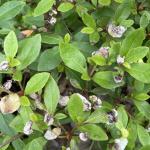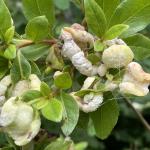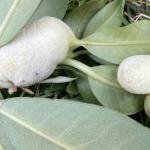Exobasidium Gall of Rhododendron and Azalea
Pathogen
Exobasidium gall is caused by several species of the fungal pathogen Exobasidium. While the taxonomy and host range of many species continues to change, it appears that E. vaccinii is one of the most common species in the United States (Walker and Benson 2014). An assortment of native and non-native Exobasidium species likely occurs in New England, due to widespread distribution through the nursery trade.
Hosts
Numerous species and cultivars of rhododendron and azalea (Rhododendron)are susceptible to infection. Exobasidium species also attack blueberry (Vaccinium) and camellia (Camellia), among other plants in the Ericaceae.
Symptoms & Signs
Exobasidium gall is a very common disease that occurs wherever rhododendron and azalea are grown in ornamental settings. Infection by Exobasidium results in hypertrophic enlargement of leaves, flowering parts and sometimes woody stems (Sinclair and Lyon 2005). The galls vary in size and color, depending on the host and specific plant part that is infected. Typically, the galls first appear pale green to cream-colored, becoming reddish-brown over time. The galls are small to large, highly conspicuous and easily diagnosed through visual assessment. Tufted growth (witches’ brooming) can also develop as a result of infection.
It’s believed that the fungus establishes from spores that overwinter in bud scales (Walker and Benson 2014). These spores then germinate and grow into the stomata on the underside of newly developing leaves or penetrate directly into developing leaves, flowering parts and succulent shoots (Sinclair and Lyon 2005). Exobasidium then grows intercellularly (between cells) within the host, parasitizing tissues and inducing hypertrophic growth that creates the distinctive swellings and galls. Most galls are annual, meaning they are produced only once from the infected tissue. They develop in late spring (late April to May) during periods of mild and wet weather. As the galls mature in early summer (mid-June to early July), they become covered in a mass of white-colored spores.
Management
Overall, Exobasidium gall is not considered a serious threat to the health of infected rhododendrons and azaleas (Walker and Benson 2014). However, the disease can result in reduced flowering and decreased aesthetic value of infected plants. Pruning or hand-picking of the galls as they appear is often recommended for disease control. However, the effectiveness of pruning out the immature galls when they first appear in the spring is unproven. Because most galls are annual, they cannot be produced again from the same tissue. Yet, removing the galls before they mature and produce a coating of white-colored spores in early summer should reduce localized inoculum. In landscapes where the disease is a problem, increasing sunlight and exposure can sometimes help to reduce disease severity. Avoid overhead watering, especially during the spring months when new growth is developing, as free moisture stimulates disease development. Fungicides are likely to have little utility against the disease. Mancozeb is one of the few fungicides labeled for use against Exobasidium, but its use is often only necessary in nursery and greenhouse settings where humidity is persistently high. Avoid the use of chlorothalonil, as it can be harmful to beneficial pollinators. Avoid any fungicide application before and during periods of flowering in the spring.
Citations
Peterson, J.L. and Benson, D.M. 2014. Leaf and Flower Gall. Pp. 35–37, In: Compendium of Rhododendron and Azalea Diseases and Pests, 2nd edn. APS Press, St. Paul, MN.
Sinclair WA. and Lyon, HH. 2005. Diseases of Trees and Shrubs, 2nd edn. Cornell University Press, Ithaca, NY.





